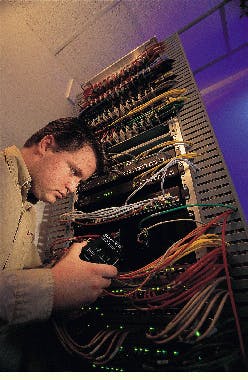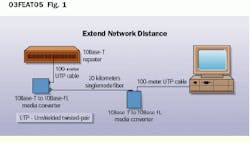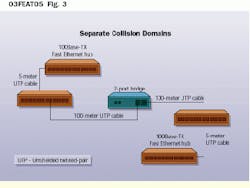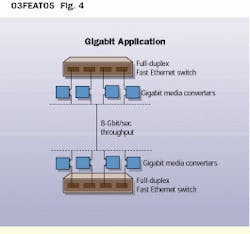The path to better-performing networks is paved with emerging technology.
David Stenger / Transition Networks
Information-systems (IS) managers looking to leap into twenty-first century technology should give careful consideration to full-duplex networks. While setting up a full- duplex network is not child`s play, it is not that difficult if proper engineering and cabling design are used and full attention is given to passive network devices.
Full-duplex networking provides for simultaneous, bidirectional transmission of data over a common medium. Whether the protocol used is Ethernet, Fast Ethernet, Fiber Distributed Data Interface (fddi), or Token Ring, full-duplex networking is the future of data communications. It will also have an impact on all of the popular networking technologies in use today.
Learning the benefits and costs associated with full-duplex connections will help IS managers maximize their networks` potential. Conversely, failing to give due regard to full-duplex transmission is akin to stifling such emerging applications as video services or extended high-speed data transfer. A typical full-duplex project will be application-driven, and time-sensitive data handling is the primary reason IS managers consider implementing full-duplex networks. Full-duplex technology also moves traffic across virtual local area networks (vlans) cost-effectively.
A full-duplex network actually allows more design freedom than a half-duplex network does. It permits a top-down approach in which the network design is determined by application, not vice versa. As long as a network is built according to full-duplex engineering guidelines, all quality of service (QoS), resource reservation protocol (rsvp), and vlan capabilities will be available.
Optimizing network performance
As you begin to design a full-duplex network, it will be important that you consider how to extend its two-way communications with attendant performance advantages as far as possible into your infrastructure. With twisted-pair cabling capable of only 100 meters in horizontal distribution, it is often necessary to consider alternative cabling types, such as singlemode or multimode fiber. However, because most active, full-duplex devices are available in copper format only, network planners risk performance loss if they must rely on fiber-optic equipment.
Media-conversion equipment provides the ability to convert transmission over standard twisted-pair cabling to signals for singlemode or multimode cabling. By deploying a full-duplex-capable converter in an Ethernet, Fast Ethernet, Asynchronous Transfer Mode (atm), Token Ring, or fddi network, you can add distance to your network and also extend the full-duplex capability as far as 20 kilometers into your infrastructure.
The Ethernet game
Since Ethernet and Fast Ethernet components comprise 80% to 90% of current sales, much of the emphasis on full-duplex development has been in this area. And, with full-duplex transmission, some of the ground rules are changing.
In a traditional Ethernet network, the name of the game is shared segments. Devices share the 10-megabit-per-second speed of the network, so a segment with 50 devices has to share the bandwidth among them, and each user ends up with 0.2 Mbits/sec. This scheme has evolved to bridged networks with smaller segments. A 500-user network could be divided into 50 segments, each with 10 users. Over time, the size of the segments has decreased as each user`s bandwidth requirements have increased.
If only two devices are connected directly by cable and are sharing the segment, those devices can talk and listen simultaneously. This effectively doubles the usable bandwidth, going from 10 to 20 Mbits/sec for Ethernet. This talk/listen capability requires switching, though, since an Ethernet hub does not have the intelligence required to deal with data-flow control. Switches can provide this flow control, transmitting data based on priority timing.
Video traffic, for example, demands priority over other applications so the transmission does not become fragmented at the receiver`s end. This gives rise to QoS considerations in any application where predictability of data flow is important.
With a typical shared network, where several devices are involved in a tug-of-war for the same medium, predictability is lost. A low-priority transmission could shut down the video stream and cause a lost connection. In point-to-point full- duplex networks, the devices can establish and maintain the connection with the proper amount of latency and predictability to make the transmission work.
In full-duplex transmission with flow control, it is possible to aggregate links. With each additional set of ports linked, the effective bandwidth is greatly expanded. This expansion is accomplished through a pair of switches with multiple ports; several of the ports on one switch are connected with ports on the other. Four full-duplex 10-Mbit/sec links can be aggregated to provide 20 Mbits/sec on each link and an effective throughput of 80 Mbits/sec between the switches. The switches` software reassembles the packets, making it appear to the user`s station that this is a single 80-Mbit/sec connection. Trunking of this kind will soon become an approved part of the ieee (Institute of Electrical and Electronics Engineers--New York) Ethernet standard. Trunking will allow groups of as many as four separate, full-duplex links to be connected through software to operate as a single connection.
As Ethernet technology has developed, the network protocol has become more predictable and controllable. Except in smaller operations, firms are migrating rapidly to switched backbones and even to providing switched connections to the desktop.
The key to any time-sensitive application is being able to predict network latency. This is impossible in a shared environment. It is possible in a switched environment and even easier in a full-duplex network.
Race to Fast Ethernet
Like traditional Ethernet, Fast Ethernet networking is also poised to dive into full-duplex technology. Maximizing the potential of Fast Ethernet will require even closer attention to the rules of the networking game than is required for 10-Mbit/sec Ethernet, however.
The 100-Mbit/sec Fast Ethernet network follows the same principles as traditional Ethernet. In full-duplex mode, two directly connected devices can send and receive data at the same time, doubling the bandwidth.
Just as Ethernet allows aggregating links, Fast Ethernet has the same provision. As a result, with Fast Ethernet a throughput of 800 Mbits/sec is possible (or eight times the normal 100-Mbit/sec speed of traditional Ethernet).
A distributed, switched networking architecture allows setting up of multiple hops to maintain a full-duplex link between two devices with switches between them. In fact, it is even possible to go switch-to-switch through other switches. This allows use of the QoS features to send a video signal, and also to maintain data integrity with the proper amount of latency and predictability.
Full-duplex Fast Ethernet has even more stringent rules for both timing and distance parameters. Because of collision- domain limitations, any Ethernet application is a bit like a relay race. The first bit of a packet has to get to the farthest node on the network and return before the last bit of the packet is sent. That is why 10-Mbit/sec Ethernet has a theoretical collision domain limit of 5120 meters. Because Fast Ethernet uses the same packet types but is 10 times faster than regular Ethernet, there is one-tenth the time to make the round trip, so the distance limitation is one-tenth the original distance, or 512 meters.
In a real-life shared or half-duplex environment, two hubs can be connected by 5 meters of cable, and from each hub to a user`s station or server you can have 100 meters of cable. So the total distance in a shared Fast Ethernet environment is 205 meters. In a full-duplex, point-to-point connection with Fast Ethernet, the network can extend up to 2 km on multimode fiber.
A good example of full-duplex transmission`s design freedom is the elimination of concerns about the collision domain in Fast Ethernet. The network can include a single large building or campus of buildings. The only concern is with the inherent limitations of the medium.
The aggregation described here applies to any network that uses the underlying Ethernet protocol, including Gigabit Ethernet.
Once the industry has identified an application that requires 8-Gbit/sec throughput, trunking four gigabit links and using this feature of Ethernet will allow the network manager to proceed with the project. The same rules apply.
Half-duplex Gigabit Ethernet is a blind alley, though. In theory, a half-duplex connection would have a maximum network size of 51 meters. It is doubtful that such a network would be deployed, since added delay from equipment would allow only about 0.2 meter of cable. With that much bandwidth, it would be possible to transmit multiple video streams. Without full-duplex transmission, it would be impossible to predict latency.
Who`s got the token?
Both fddi and traditional Token Ring are token-based networking schemes. Contrary to early predictions that Token Ring would end up the old maid of networking, recent improvements have extended its useful life and attractiveness.
Full-duplex deployment of fddi is being pushed ahead because of application requirements. Just as Ethernet did, fddi started off in a shared environment but moved to a switched environment, cutting down the number of nodes on each segment and yielding more bandwidth per node.
In a point-to-point fddi network, the early answer was to eliminate the token. This allowed anyone to transmit and receive at the same time and drove speeds up to a theoretical 200 Mbits/sec for the connection. Since it was predictable in terms of time between transmissions, it is possible to use video at 100 Mbits/sec for each connection.
The last one to join the full-duplex game was traditional Token Ring. Similar to what was done with fddi technology, the token was eliminated in a point-to-point, full-duplex connection, allowing users to transmit and receive packets at the same time.
Presentations with multimedia, streaming video, and the rise of corporate intranets have all driven full-duplex into the Token Ring market. The large number of Token Ring networks that use full-duplex transmission might surprise some people, in fact.
Keep in mind, however, that the installed base of Token Ring is huge. Most mission-critical applications reside on mainframes or AS/400 computers. Many of those applications cannot be ported to an Ethernet network.
With full-duplex connections, the Token Ring network gets not only more bandwidth, but also more predictable bandwidth.
Token Ring switching has given the technology a second wind in the networking race. A 100-Mbit/sec Token Ring protocol will be available this year. By late 1998 or early 1999, Gigabit Token Ring will hit the market. Every vendor in the High Speed Token Ring Alliance--including 3Com, Bay Networks, Cabletron Systems, Cisco Systems, ibm, Madge, Novicom, Olicom, and Xylan--support full-duplex point-to-point Token Ring at 100 Mbits/sec.
Initially, 100-Mbit/sec Token Ring will run in a point-to-point environment, with full-duplex transmission optional. Token Ring has full-duplex written into the standard as Dedicated Token Ring, 802.5-R. Implementation will require only a software change.
What about atm?
Quality counts, so wherever network managers gather, the air is abuzz with talk of atm and its promise of improving QoS. Some observers see atm as the bully that will ruin Ethernet and Token Ring, so the lan environment has come to another crossroads. The threat of atm and its offer of QoS and multimedia performance has pushed the frame-based networking companies to counter this technology.
rsvp and Layer 3 routing have the potential to offer many of the same advantages. Even the possibility of unlimited scalability has been matched with the movement of Ethernet to Fast Ethernet and especially Gigabit Ethernet speeds.
Layer 3 is the network layer in the open systems interconnect (osi) reference model. Its main function is to provide reliable, in-sequence delivery of data between the other transport layers. This layer is used to define data call establishment procedures for packet and cell-switched networks.
Setting up a frame-based, multimedia-capable lan requires a novel implementation of the Ethernet protocol. These new, fully switched and switch-heavy networks make a high-technology break from the days of shared-bus Ethernet. Bringing Layer 3 routing and high-performance multimedia to an Ethernet environment is best done by creating full-duplex switched connections between demanding network components.
No matter what the networking game, full-duplex transmission will be a winner. The challenge for the IS manager is to migrate to full-duplex transmission without jeopardizing the investment already made in the existing network. Solutions such as those offered by media-conversion technology can help protect the lan environment and prepare it for future demands.
David Stenger is a product manager for Transition Networks (Minneapolis, MN), which specializes in conversion technology.
David Stenger, product manager at Transition Networks, inserts a media converter into an 8-slot rack, one of two converter rack options available.
A media converter can help link, via singlemode fiber, two 10Base-T networks that are 20 kilometers apart.
By connecting the ports on two Fast Ethernet switches, you can substantially increase the effective throughput. Soon this type of trunking will be officially recognized by the body that issues Ethernet standards.
A shared Fast Ethernet network, limited to 205 meters with half-duplex operation, can be extended to 2 kilometers in a full-duplex, point-to-point environment over multimode fiber.
Throughput of 8 Gbits/sec would allow transmission of multiple video streams on a Gigabit Ethernet network.




